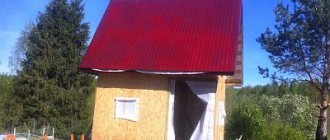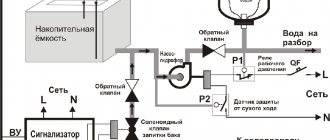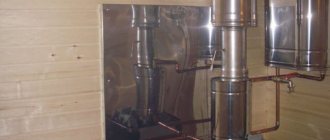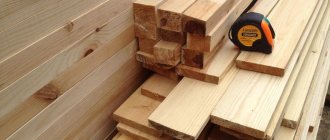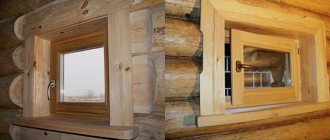Construction of a bathhouse is a rather expensive process. If you purchase all the equipment in a store, the steam room can cost a significant amount. Therefore, craftsmen and just people who want to see this structure on their plots strive to build a steam room with their own hands. Last but not least, this also applies to heating devices.
What is better: taking a ready-made cauldron to the bathhouse or making it yourself? To solve this dilemma, you need to consider all the pros and cons of making it yourself and identify possible difficulties that may arise during its production. It must be said right away that it is better not to try to make a gas boiler for a bath yourself.
Firstly, a self-made unit can fly into the air, taking the bathhouse with it.
Secondly, the operation of such equipment is strictly prohibited by safety regulations.
At the same time, you can make a boiler for a wood-fired sauna yourself if you have all the necessary equipment and your hands grow from the right place. Boilers for wood-burning saunas can be made from a metal barrel with thick walls, pipes or sheets of steel. There is no shortage of them in any subsidiary farm.
Main components of a sauna boiler
Any stove, including sauna boilers, consists of the following elements:
- A firebox in which the combustion process of wood, coal and other types of fuel occurs. It is made of thick metal. This is due to the fact that the firebox has the highest thermal load, metal of insufficient thickness will quickly burn out, and a homemade boiler for a bath will become unusable. A wood-burning boiler for a bath, namely a firebox, must be equipped with grates. Through them, ash from burnt fuel spills into the ash pan. The thickness of the metal from which they are made must be at least 0.5 centimeters.
- A chimney through which smoke is removed. When deciding how to make a boiler for baths, you need to thoroughly understand the principle of operation of the chimney system and carefully calculate its dimensions. The slightest mistake when installing a chimney can lead to insufficient efficiency of the stove (heat will go into the chimney) or an inability to cope with the removal of combustion products. The chimney must be equipped with a valve, with which the draft level is regulated. In winter, a tightly closed valve greatly contributes to the preservation of heat in the room. The chimney pipe may pass through the heater or be part of a heat exchange system.
- An ash pan designed to accumulate ash. This boiler element is located under the firebox. In addition to its main function, it is responsible for the supply of air, which is an integral component of the combustion process. When making a boiler for a bath with your own hands from pipes, you should carefully calculate the dimensions of the ash pan. It should be able to hold enough combustion products to be cleaned once a day.
- A heater that redistributes and removes thermal energy. It is a built-in or hanging container in which stones are placed. Its volume depends on the size of the boiler and steam room. A small heater will not be able to heat the room, and a large one will take too long to heat up. During this time, the water boilers have time to boil, which causes the room to fill with water vapor. At the same time, the steam room will become uncomfortable. The size of the heater and water tank should not be different. You can make a cauldron without a heater, but this is not entirely convenient. The room will be heated only from the walls of the boiler. In addition, it will not be possible to “give in to the park.”
- A water tank that is part of the heat exchange system. Cast iron sauna boilers with a water tank are the most common solution.
After the main components of the device that produces heat have been identified, we should move on to the main question: how to make boilers for a bath from scrap materials?
Design of a homemade boiler for a steam room
Drawing of a homemade boiler for a bathhouse
Sauna stoves operate under different conditions than wood heating boilers, hence the differences in design:
- Any homemade boiler for a bathhouse does not have a water jacket; the walls of the firebox give off heat directly to the air in the room.
- The firebox body is made of steel, since it is unrealistic to make cast iron at home.
- There are no internal channels for flue gases, and the chimney has a minimum number of turns, since the temperature of the gases at the outlet is high. The result is that the metal burns out at the point of rotation or connection.
- The loading door is located in the outflow channel. The combustion chamber is located in the steam room, and it needs to be loaded with firewood from the dressing room, so a channel is made to pass through the wall.
As a rule, homemade sauna boilers are made in two types: cylindrical and rectangular. The design of the former is more accessible in terms of materials and is easier to manufacture. The manufacture of a rectangular stove will require more financial and labor costs, but such boilers work better and are more popular.
What materials and tools are needed to make a boiler?
Boilers for steam rooms in Russian baths are made using the following tools:
- welding machine;
- grinders, with a cutting wheel designed for working with metal.
We’ll talk a little later about how homemade sauna boilers are made from a pipe or barrel. First, we should talk about the most common sheet metal option. In addition to this you will need:
- small pieces of reinforcement and channels - they are needed for the manufacture of internal partitions;
- a thick sheet of metal (minimum 0.5 centimeters) - it is necessary for the production of grate bars;
- pipe with a diameter of at least 10 centimeters;
- awnings for firebox and vent doors;
- faucet for tank.
When talking about how to weld boilers for a bath, we should mention the manufacture of a heat-distributing screen. It is best made from brick. All you need to do is to tightly surround the boiler with it.
Weight and overall dimensions of boilers
According to these indicators, the selection is as individual as possible. A large number of metal sauna boilers are relatively lightweight, which allows them to be installed directly on the floor of a steam room or other room. But you need to take into account the dimensions of the floor beams or joists and check their load-bearing capabilities with the parameters of the boiler.
Light metal furnaces and boilers do not require a separate foundation
If the boiler is quite large and heavy, then its installation must be provided for during construction work: prepare a concrete foundation or use reinforced beams and flooring at the installation site. Dimensions are taken into account taking into account the size of the steam room and the specific location of the boiler.
Base for a massive stove or boiler
Important. During installation, pay attention to the location of the ceilings and rafter system; they should not interfere with the installation of the chimney. If problems arise, you need to purchase different elbows to change the location of the chimney outlet on the roof or bring it outside through a special hole in the wall.
Chimney outlet between the rafters
Barrel stove
How to choose boilers for baths? What material should be used for their production?
Such decisions should be made independently, taking into account the availability of components. Some people find it more convenient to use sheet iron, while others think that it is better to make boilers for a bathhouse with your own hands from a barrel or pipe. They are no different and boast the same heating of water in containers and the room as a whole. The difference lies in the method of production.
To be fair, it must be said that it is much easier to make a boiler for a bathhouse with your own hands from a barrel. This is the simplest design. All you need is to find a metal container with a wall thickness of at least 0.3 centimeters. Thinner metal will burn quickly.
You need to make a boiler for a wood-burning sauna from a barrel in the following order:
- The bottom of the container is completely cut out. Instead, a sheet of iron with a thickness of at least 0.5 centimeters is installed. It is necessary to weld the legs to it in advance, which can be made from scraps of a T-beam.
- At a height of 5–7 centimeters from the bottom, you need to cut out a small window (approximately 20x15 cm). The blower door will be installed at this location. It is made from a sawn piece. You need to weld the hinges and handle to it, and then install it in its rightful place.
- The second door of the future boiler for a wood-burning sauna is installed 20 centimeters above the vent. It should be significantly larger than the first one (approximately 25x45 cm). Otherwise, the logs will not fit into it.
- A boiler for a wood-fired sauna contains grates in its design. They need to be placed 5–7 centimeters below the firebox door.
- A heater must be placed above the firebox. The most convenient place for its location is the second third of the barrel. The partition between these sections of the boiler should not be continuous. It is made from channels. The size of the heater is equal to the second third of the barrel. A door is needed in the middle of the heater. Stones are laid through it and water is poured in, if desired, to “give it to the park.”
- From a barrel you can make a boiler for a sauna with a tank. To do this, use the remaining third of the barrel. The heater and tank are separated by a solid partition, the seams are thoroughly boiled. A chimney pipe must be installed in the center of the tank.
Having studied the drawings of such structures, you can easily build a stove. There's nothing complicated about it. All you need to make a sauna cauldron with your own hands is to strictly follow the existing instructions. Before operation, the manufactured sauna boiler must be cleaned of scale and rust.
If desired, it can be painted with heat-resistant paints and varnishes. That's all. A DIY cauldron made from a barrel is ready. It can be installed in a bathhouse.
Heating into a bathhouse from a pipe is done in the same way. The only exception is the initial stage. You will not have to cut out the bottom of the barrel, but you will need to maintain the dimensions by cutting a pipe 1.2–1.4 meters long.
Installation recommendations
Long before making a boiler for a bath, you need to decide on the location and diameter of the chimney pipe. The design of a homemade stove should take these points into account, so that later you don’t have to make several turns of the chimney, which will affect its service life. If you decide to place a tank for heating water on a pipe, then it should rise straight up and go through the roof. Starting from the ceiling lining and until the very end, it is recommended to use two-layer sandwich pipes for the chimney. The temperature of the flue gases in it is quite high, so the pipe should not be in direct contact with the elements of the ceiling and roof. A detailed diagram of how to install a boiler in a bathhouse is shown in the figure.
Boiler installation
The unit cannot be placed on floors; it requires a foundation in the form of a slab of concrete or brick. Wall surfaces lined with wood that are nearby must be protected from heat flow using screens made of basalt materials. Some homeowners are thinking about how to paint the boiler in the bathhouse in order to improve the interior. There are special industrial high-temperature paints, but their use is impractical. The burning temperature of wood is 600 ºС, any paint will have to be renewed frequently, and its cost is very high. It is better to install a heater on the entire body, as described above, or line the boiler with ceramic bricks.
Article on the topic: How to weld a sauna stove from a pipe
Sheet iron heating device
A similar stove with a metal boiler for a bathhouse is the most difficult to produce. This is due to the fact that there will be no prepared workpiece. Fundamentally, such a device is no different from the one described above. It also contains 4 compartments: an ash pan, a firebox, a heater and a tank.
The production of such a furnace will take longer. You will especially have to tinker with the water tank, which should be practically sealed. But the result will be a product no different from what was produced at the factory.
Advantages and disadvantages
Let's try to evaluate gas against the background of traditional fuel for a bath - firewood.
Advantages
- Kindling takes no time at all. It only takes some time to warm up the room.
- The stove can be more compact and take up less space - there is no firebox or ash pan.
- Temperature adjustment is easier. Much easier. The thermostat allows you not even to adjust the burner flame, but to set the required temperature.
- There is no longer any need to maintain the stove - cleaning coals and ash.
- Fire safety is higher than that of wood stoves. Remember how often the cause of a fire is a coal that has jumped out of the stove.
- Fuel no longer needs to be stored in a dressing room or under a canopy outside; You can also forget about the need to chop wood.
- Smoke indoors? Long-term heating of the chimney? What are you speaking about?
- Finally, the price per kilowatt-hour of heat for main gas remains the lowest among all coolants.
The chart allows you to compare costs when using different types of fuel.
Flaws
Perhaps, after listing the advantages of the solution, the reader was filled with delight and adoration for gas equipment.
Let's try to take off his rose-colored glasses.
- Gas equipment is explosive. Yes, blocking the gas supply when the flame goes out is now everywhere; however, it will not prevent leaks at the connection in front of the furnace.
- The aroma of burning wood is one of the sources of the pleasure that a sauna brings. Alas, gas will not provide it.
- Procuring firewood yourself instead of buying it will change the price balance. In addition, main gas is not available everywhere; balloon heat is several times more expensive per kilowatt-hour of heat.
Horizontal boiler for a bath
Along with vertical heating devices, homemade stoves made from pipes and barrels with a horizontal design are no less popular. These products are easy to make:
- You need to take a two-hundred-liter barrel and cut several holes in it. Two of them are intended for installing a heat exchange pipe. It should pass right through the barrel. Two more will serve as a blower and firebox door. The last hole is necessary for installing the chimney.
- You can make a heater in the upper part of the future stove. Part of the barrel is cut off, and reinforcement bars in the form of a lattice are welded in this place. Next, you need to weld a structure from sheets of iron in the shape of an unfinished inverted pyramid.
- The stove blank is equipped with legs, after which it must be connected to the chimney and heat exchange system.
Making such a structure is no more difficult than a boiler made from a barrel installed vertically. The disadvantage of this product is that it takes up a lot of space.
Long burning boilers
Long burning boiler - photo
Functioning long-burning boiler
They appeared quite a long time ago and have their advantages and disadvantages. Manufacturers claim that one load of firewood will burn for a long time, and this will ensure fuel savings and stable room temperature. To understand what is the truth and what is a publicity stunt, you need to remember your school physics lessons. To heat a room you need thermal energy. For example, one armful of firewood during combustion can release 1 Gcal of heat. If wood burns in an ordinary boiler for an hour, then during this time 1 Gcal of heat is released. In the boiler, the same wood will burn for 10 hours and during this time 1 Gcal of heat will also be released. Note, not more, but exactly the same. This amount of heat can increase the temperature in the steam room by 100°C within an hour, or by 10°C in ten hours. For clarity, we used conventional numbers, this makes it easier to understand the meaning. Do you need a long-burning boiler in a steam room to keep it slightly warm?
Long burning boilers Stropuva
Factory-assembled long-burning solid fuel boilers
There is one more nuance you should know. The burning time is regulated by the amount of air supplied to the firebox. Less oxygen means wood burns slower, more oxygen means wood burns faster and releases thermal energy. The combustion process can be controlled much more easily. Buy boilers that have adjustable holes on the ash door or firebox (or make them yourself), increase/decrease the amount of air as needed and you will have a long-burning boiler without large financial costs.
Adjustable oven door
Factory long-burning boilers have quite a lot of different additional equipment, which costs a lot of money. And the effectiveness of its use is approaching zero.
Long burning boiler
Electric heating in the bathhouse
If there is a need to heat only the steam room, then the ideal solution is a solid fuel stove. Otherwise, when you need to heat the dressing room, shower room and other rooms in the bathhouse building, this option can be safely discarded.
To heat a large area, it is better to use an electric boiler. Its production and installation do not have any technical difficulties. All that is needed is to weld the water heating elements into a container of water and properly arrange the heat exchange system.
The advantages of sauna boilers running on electricity are obvious:
- there is no need to equip a chimney system;
- ease of installation, operation and maintenance;
- high efficiency.
Along with the advantages, there is a significant drawback: significant energy consumption.
Bath tub: relaxation in the fresh air
A metal bathtub in the shape of a hemisphere or polygon can be called the forerunner of modern Jacuzzi bathtubs. A capacious vat is installed in an open area, often next to a bathhouse or a water source. Depending on the size, the sauna vat can accommodate from 2 to 6 people.
About 2 hours before bathing, fill the container with clean fresh or mineral water, adding herbs, decoctions, and healing salts if desired. To heat the water and maintain the desired temperature, the vat is fixed directly above the stove or open fire. The temperature is brought and maintained at a level of 40-50°C.
For 2 – 4 people, a container with a diameter of 2 m and a height of 73-75 cm is sufficient; a sauna vat with a diameter of 2.2 m can accommodate up to 6 people. For business, they often install a container with a diameter of at least 2.5 m, a depth of 83-90 cm, designed for bathing 8 - 10 people.
Despite the similarity of the “bath in a vat” to a tourist cauldron, the design is completely safe. Inside the tank, a floor made of processed stone, flat river stones or wooden flooring and benches for bathers are installed so as not to come into contact with the heated bottom of the vat during water procedures.
The edges of the “cauldron” remain cold, so you can hold on with your hands or lean on your back without fear of getting burned.
Advantages and disadvantages
Advantages of installing an electric heating boiler for a bath:
- cost-effectiveness - with a competent approach to the selection of characteristics, you can find a model that will justify itself in terms of the ratio of functionality to resource consumption;
- ease of installation - the device does not require a separate room or chimney arrangement;
- environmental friendliness - as a result of using the unit, no emissions hazardous to the environment are generated;
- there is no need to purchase or prepare fuel;
- you can set and automatically maintain a specific temperature;
- advanced models are equipped with remote control programs and are able to function autonomously;
- no effect of dried air, the ability to interface with steam generators;
- fire safety;
- loyal price range;
- the devices do not require labor-intensive maintenance;
- operating conditions are characterized by high humidity, the “filling” of the units is well insulated.
In regions with periodic power outages, generators are often purchased to eliminate emergency situations. A significant disadvantage of electric boilers for baths is their vulnerability to power surges. For models that are not equipped with a built-in filter, it is worth purchasing a stabilizer.
Manufacturing options
There are several basic options for making sauna boilers with your own hands. Drawings of the device must be made as accurate as possible to avoid various errors during assembly.
From a metal pipe
This method of creating a boiler is considered the most popular and most used. Most often, thick-walled metal pipes are used as the main material. It is best to use blanks with a diameter of at least 50 cm and a length of approximately 1 m. With their help, you will get a device capable of heating a steam room with an area of 9 square meters.
The boiler manufacturing process is simple and consists of the following steps:
- Three identical pieces with a diameter of 1.4 cm and a length of 30 mm are cut from the reinforcement. These parts will be used as supports for the body of the product.
- A circle (the bottom of the future device) of the same diameter as the pipe is cut out of a sheet of steel.
- A metal lid for the stove is cut from a piece of material.
- A hole is made in the middle. Its size must exactly match the diameter of the chimney.
- A hole is formed at the bottom of the pipe.
- Then the box is made. A separating part should be provided inside it, which will form two chambers: for the firebox and for the ash.
- At the next stage of work, the assembly of the structure begins. First of all, the manufactured box is welded, which should go outside or into the combustion chamber.
- The chimney pipe is inserted into the pre-made hole.
- Then the foundation for the furnace is equipped. It can be a concrete screed or a reinforced concrete slab.
- The device is installed on it, and heavy stones are placed on top of the lid.
- At the very end, a brick heat shield is built. You can make it in the form of a small wall or cover the entire boiler.
From sheets of metal
This manufacturing option is distinguished by its simplicity and accessibility. The work uses inexpensive sheet steel with a diameter of 5 and 10 mm, as well as some materials that can be bought at any hardware store in the city.
To independently weld a sauna boiler from metal sheets, you need to perform several simple operations.
Procedure:
- A drawing of the future product is drawn with a detailed representation of the most important components.
- Separate blanks of the required size are cut from purchased sheets of metal. Moreover, they must exactly correspond to the manufactured diagram of the sauna boiler.
- A piece of thick-walled material is folded over and forms the body of the device.
- Then the edges are welded to each other. It is important to make the seam as smooth and high quality as possible. If there are no opportunities or skills to carry out such work, then it is best to hire a qualified specialist.
- A piece of pipe is welded into the inside of the manufactured body.
- Then a water tank is formed.
- A wide hole is made in the combustion chamber and a chimney pipe is installed into it.
- A special valve is attached to it, which will control the traction force.
- A combustion door is attached to the structure.
- A small tube for connecting a tap is attached to the back of the boiler.
- A protective brick screen is built around the device. Thanks to it, the negative impact of high temperatures on people will be reduced. In addition, it will protect against accidental touch and severe burns.
Making a boiler for a sauna with your own hands is a rather difficult undertaking that requires a significant investment of time and money. With the right approach to business and following all recommendations, you can make high-quality equipment that will work correctly for many years and bring pleasure to people.
Power control mechanisms
One of the main criteria for choosing equipment for a bath is temperature control tools. There are only 2 scenarios on the specialized market: stepped and smooth.
Models operating on the basis of several heating elements usually provide stepwise power adjustment. To change the operating mode of such a boiler, it is necessary to activate or turn off some of the heating elements. Depending on how many of them will be involved in the work, you can set 4 power levels from 25% to 100%.
Step power adjustment
But judging by user reviews, smooth adjustment is more comfortable and economical, since it can be used to set specific temperature parameters. A smooth transition between indicators is ensured using a rheostat.
You can find budget models on sale that are characterized by low power and do not provide adjustment tools at all.
Choice
What are the characteristics of gas stoves intended for baths?
Stones
The traditional stove for a Russian bath - a heater - is distinguished by a large number of round stones placed in a tray. The tray is located above the firebox and, after lighting the stove, heats up quite quickly; the stones heat up to temperatures of 200 degrees or more.
They perform a dual function:
- By accumulating heat, the stones maintain a high temperature in the steam room after the wood burns out.
- The very name “steam room” implies the presence of steam. The traditional mode for a Russian bath is 60 degrees with very high humidity. To add steam, just splash water from a ladle onto the stones.
Gas heater Ermak.
If you are a fan of the Russian bathhouse, a heater is your obvious choice. If you want to use a sauna with high temperatures and minimal humidity, you don't need stones. Heat accumulation in the case of gas, you understand, is of no value.
Water tank location
It may be located in the stove body or around the chimney. In the first case, the heat source for heating water is the burner flame, in the second - combustion products. In the author’s humble opinion, the second option is preferable: the tank additionally cools the combustion products, increasing the efficiency of the device.
Gas stoves
If you use bottled gas, a stove that combines two types of fuel would be an excellent solution for you. When the cylinder runs out, you can light the stove with wood.
Burner
Often it is purchased separately.
What should you pay attention to when purchasing?
- With a steam room volume of 18 m3, the reasonable maximum gas consumption by the burner is 1.5 m3 per hour. It is easy to recalculate the required productivity for your volume.
- The registration certificate and markings must be present. Automatic shutdown when the flame goes out is mandatory (in fact, now it is available almost everywhere).
- Any damage, even seemingly uncritical, puts an end to the device. Big and fat. We are talking about people's lives and health.
Domestic burner Teplofor.
Technical characteristics of an electric boiler for a bath
Indeed, electric heating units have many advantages when it comes to installation in a sauna.
However, they can only be felt if the parameters and characteristics of the electric bath boiler are taken into account correctly. Start with the network where you plan to connect it - this data will be your starting point in choosing the power parameter of the device. Here you can have 2 options: a single- or three-phase wire, that is, the voltage in it is 220 V or 380 V, respectively.
Another point is the power of the device itself. Thus, ordinary wiring with a voltage of 220 V will “cope” with an electric boiler with a power of up to 6 kW. If the wiring of the same 220 V is new, done correctly and efficiently, you can take a closer look at more powerful units - from 6 to 12 kW.
If you need a heating device more powerful than 12 kW, then you will not have a choice, since such devices operate only from a three-phase network. Although some manufacturers of electric boilers have models that can connect to both a 220 V network and a 380 V network.
When choosing the power of an electric boiler, experts recommend first of all focusing on the area of the room: to heat 10 m2, the device will require at least 1 kW. Also pay attention to models with power supply in pulse mode - they are not afraid of voltage sags in power lines.
Equipment and functionality
It is advisable that the kit contains all the necessary strapping elements (purchasing them separately will cost more):
- circulation pump;
- expansion tank;
- fine filter;
- safety valve;
- thermostat.
A useful feature is an automatic shutdown system in an emergency or under unfavorable conditions (overheating, pressure drops in the system, etc.).
It is desirable that it be possible to switch from winter to summer mode and back: this helps save energy (how much does an electric heating boiler consume per month).



